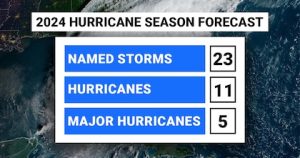CSU Researchers Predicting Well Above-Average 2024 Atlantic Hurricane Season
April 4, 2024Colorado State University hurricane researchers are forecasting an extremely active 2024 Atlantic hurricane season, predicting 23 named storms, 11 hurricanes, and five major hurricanes in their initial outlook released Thursday.
This forecast, which marks the highest prediction for hurricanes ever issued by CSU in April, is driven by several key atmospheric and oceanic factors indicating heightened hurricane activity.
The Atlantic hurricane season officially spans from June 1 to November 30. Researchers anticipate eleven to develop into hurricanes, with five potentially reaching major hurricane status (Category 3-4-5) characterized by sustained winds of 111 miles per hour or greater.
The primary factor influencing this forecast is the presence of record warm sea surface temperatures across the tropical and eastern subtropical Atlantic. When these waters are significantly warmer than usual, they contribute to the weakening of the subtropical high and associated winds blowing across the region. This phenomenon is expected to persist throughout the peak of the hurricane season, providing ample fuel for storm development and intensification.
Additionally, although the tropical Pacific is currently experiencing El Niño conditions, these are projected to transition into La Niña conditions by the peak of the Atlantic hurricane season. La Niña typically reduces upper-level westerly winds across the Caribbean and tropical Atlantic, thereby decreasing vertical wind shear—a condition that favors the formation and strengthening of hurricanes.
Phil Klotzbach, senior research scientist in the Department of Atmospheric Science at CSU and lead author of the report, highlighted the parallels between the 2024 season and historically active seasons like those observed in 1878, 1926, 1998, 2010, and 2020.
The forecast indicates that 2024 hurricane activity is anticipated to be approximately 170% of the average season observed between 1991 and 2020. This contrasts sharply with the 2023 season, which saw hurricane activity at about 120% of the historical average. The most notable hurricane of 2023, Hurricane Idalia, made landfall in Florida as a Category 3 storm, causing significant damage and fatalities.
The CSU forecast, now in its 41st year, serves as a critical tool for coastal residents and emergency management authorities, providing valuable insights into the potential severity of the upcoming hurricane season. Despite the forecast’s confidence in an active season, researchers caution that it only takes one storm to significantly impact a specific region.
The report also includes probabilities of major hurricanes making landfall along various coastal regions, emphasizing a heightened risk for the entire U.S. coastline, the U.S. East Coast including Florida, the Gulf Coast from the Florida panhandle to Brownsville, and the Caribbean.
As the 2024 Atlantic hurricane season approaches, coastal communities are urged to remain vigilant and prepared for potential impacts.















